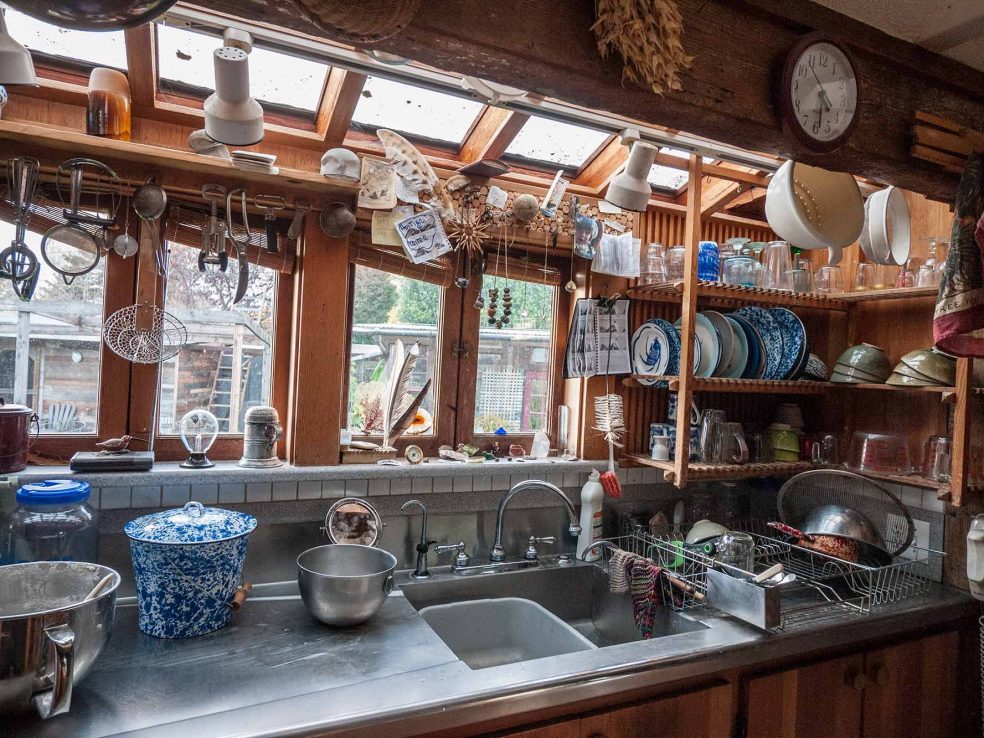
Louie is the featured builder in our book Home Work. I stay in the little circular room at the right when I go up to hang out with Louie..

My book Driftwood Shacks is just about to go to the printers in Hong Kong, and now I’m starting to assemble the next one: Handmade: The Half-Acre Homestead, which covers 50+ years of building, gardening, cooking, foraging, fixing, and other aspects of creating our own shelter and food. In coming months, I’ll put up preview photos from this book.
This is our kitchen. The stainless steel sink was $100 at a salvage lumberyard. A key feature is that the sideboards drain into the sink. Most kitchen sinks have a rim around the edge, and the sideboards do not drain into the sink.
The dish rack at the right was designed and built by Lew Lewandowski about 20 years ago; after the plates and saucers and glasses are washed and rinsed, they are put in the rack to dry — and they stay there.
There’s a 5-gallon electric hot water heater directly under the sink. I don’t like the idea of electric heat, but in this case, it’s a small amount of electricity and moreover, you get almost instant hot water.
Here’s a YouTube video I did of our dishwashing system: www.youtube.com/…
If you like this blog, please email your friends about it: lloydkahn.com We need to generate more traffic so more people will know about our books.

 This is 10′ by 10′. Rafters made of four 1″ by 4″ by ⅜″ redwood bender board, 16′ long, bent, glued and clamped together. Roof sheathing is 1 × 6 redwood fence boards from Home Depot. Siding is ⅜″ rough-sawn exterior DF plywood. Eventually I’ll panel the inside with used fence boards. Flooring is used yellow pine T&G from Heritage Salvage in Petaluma. Windows (used) from Urban Ore in Berkeley.
This is 10′ by 10′. Rafters made of four 1″ by 4″ by ⅜″ redwood bender board, 16′ long, bent, glued and clamped together. Roof sheathing is 1 × 6 redwood fence boards from Home Depot. Siding is ⅜″ rough-sawn exterior DF plywood. Eventually I’ll panel the inside with used fence boards. Flooring is used yellow pine T&G from Heritage Salvage in Petaluma. Windows (used) from Urban Ore in Berkeley.
Billy Cummings has done most of the work here, including cutting and fitting double-wall polycarbonate greenhouse glazing under the curved eaves.
Next step is to build a sliding door for one half of the end wall shown here so a bed can be rolled out onto the deck for nighttime star gazing. Jay Nelson built a sliding door for his shop that gave me the idea.
Note: A curved roof is infinitely more time-consuming (In many ways) as compared with, say, a shed roof or a gable roof. BUT the space underneath is wonderful and something I highly recommend for tiny homes. If you take the time to build a roof like this, it will give you a feeling of spaciousness and avoid the claustrophobia of small spaces. Curved roofs are the secret to the good feeling in Gypsy wagons (vardos).
Hey, I’m starting to get the hang of doing layout in WordPress — a lot more options than Blogger.

Too bad that the hundreds of houses at the coastal development Sea Ranch, which were supposed to be modeled on local farm buildings such as this one, turned out to be so sterile. The one part of Sea Ranch design that did work, was the landscaping by landscape designer Lawrence Halprin; he basically left the natural vegetation as is.

This is my favorite home in the world. Built by Lloyd House and featured in Builders of the Pacific Coast, it’s on a small island in British Columbia. When I first saw it, it took my breath away. It was just perfect. The materials, the size, the shape, the way it fit into the environment as if it had grown there.
Funny thing: After 40+ years photographing builders and their buildings, I meet the builder of my dreams, and his name is Lloyd — House!
Even though we seldom see each other, we’re good friends. He’s built dozens of wonderful buildings in his career — most of them shown in the above book.
BTW, this is my favorite of all seven of our building books. It’s a story, an odyssey, from start to finish, hanging out with these wonderful people in British Columbia and documenting their unique creations. My intent was to take the reader along, riding shotgun, in my excursions to this land of wood and water.

This is a brilliant way to add square footage. A minimal, lightweight, inexpensive roof and deck give you an expanded living area (during good weather). The warmer the climate, the better this works. You can barbecue, eat, and socialize out on the deck.
I saw a place in Baja where the gringo owner, who came there only periodically, had built a small concrete block unit with a steel door where he locked up and stored all his stuff. He had a large roofed-over with a split bamboo covering for shade; when he came down to his land, he opened up the unit, pulled everything out (including hammocks), and lived mostly outside.



Old guys at work. 153 years of age total here. Billy and I have worked together off and on for 47 years.
I’ve wanted to build a curved roof for a long time. I finally did it, with help from Billy Cummings. For the 6 rafters, we glued together 4 pieces of redwood bender board — 16′ long, 1″ by 4″, ⅜″ thick, using a jig laid out on the floor, with Titebond wood glue, and clamping every foot or so. It was a pretty tedious process, we could only do one a day.
We got the rafters in place, Billy did the blocking on the plates, and we used 1×8 rough redwood fence boards for the sheathing. Yesterday we put down the flooring — used shiplap pine from Heritage Salvage. It looks (and feels) great.
There’s nothing like a curved roof, especially with a tiny home; it gives you a feeling of spaciousness. This is the roof shape in gypsy wagons — vardos.
This is 10′ by 10′. If I did it over, I would make it rectangular, like 8 by 12 or 8 by 14. I’m going to put a bed inside on wheels, that can be rolled out on the deck to sleep out under the stars. I’m still figuring out where to put windows.
 Funky, but it shows an interesting variation: a dormer that would make the otherwise claustrophobic loft feel more spacious. I don’t remember seeing this on any of the typical steep-gabled tiny homes. Also, note the shakes for rain protection over the door.
Funky, but it shows an interesting variation: a dormer that would make the otherwise claustrophobic loft feel more spacious. I don’t remember seeing this on any of the typical steep-gabled tiny homes. Also, note the shakes for rain protection over the door.
 It was a hassle gluing up these 6 laminated curved rafters (out of 16′ long redwood bender board — 4″ wide by 5/16″ thick). I brushed glue on both sides of each piece, then bent in a floor jig and clamped every 20″ or so. Tedious, could only do one every day or two. Enter Billy, who planed therm down and strategized with me, and figured out how to get them into position, pinned down at the plates and evenly lined up in height. It surprised both of us how good it looked when we got them in place.
It was a hassle gluing up these 6 laminated curved rafters (out of 16′ long redwood bender board — 4″ wide by 5/16″ thick). I brushed glue on both sides of each piece, then bent in a floor jig and clamped every 20″ or so. Tedious, could only do one every day or two. Enter Billy, who planed therm down and strategized with me, and figured out how to get them into position, pinned down at the plates and evenly lined up in height. It surprised both of us how good it looked when we got them in place.
This is a 10′ by 10′ shed, and I wanted the curved roof for the feeling of spaciousness it affords in small spaces, witness vardos (gypsy wagons) or Basque shepherd’s wagons. Steep gable roofs for tiny homes are, to me, claustrophobic. And, while I’m at it, the typical tiny home loft at one end, reachable by a vertical ladder, is just plain bad design. In vardos, the bed is at one end, floor lever, with drawers beneath it.
This place is going to have a deck for sleeping under stars, facing east. Like most of what I do, I don’t have a definite plan, just designing it in the process of building it. Boy is it fun to be building (even something small) again.













